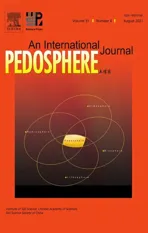Soil micromorphological and physical properties after application of composts with polyethylene and biocomponent-derived polymers added during composting
2021-10-15MonikaMIERZWAHERSZTEKKrzysztofGONDEKAltafHussainLAHORIMichaKOPERyszardMAZUREKTomaszZALESKITomaszABandJerzyWIECZOREKDepartmentofAgriculturalandEnvironmentalChemistryUniversityofAgricultureinKrakowalMickiewiczaKrakowPoland
Monika MIERZWA-HERSZTEK*Krzysztof GONDEKAltaf Hussain LAHORIMichałKOPEĆRyszard MAZUREKTomasz ZALESKITomasz GŁ˛AB and Jerzy WIECZOREKDepartment of Agricultural and Environmental ChemistryUniversity of Agriculture in Krakowal.Mickiewicza Krakow -0(Poland)
2Department of Mineralogy,Petrography and Geochemistry,AGH University of Science and Technology,al.Mickiewicza 30,Krakow 30-059(Poland)
3Department of Environmental Sciences,Sindh Madressatul Islam University,Karachi 74000(Pakistan)
4Department of Soil Science and Soil Protection,University of Agriculture in Krakow,al.Mickiewicza 21,Krakow 31-120(Poland)
5Institute of Machinery Exploitation,Ergonomics and Production Processes,University of Agriculture in Krakow,ul.Balicka 116B,Krakow 31-149(Poland)
ABSTRACTComposts are considered to be one of the best soil amendments.However,the effects of composts with added polymeric materials on soil physical,hydraulic,and micromorphological properties have not been widely discussed.Changes in soil physical properties influence the numerous services that soils provide.We studied the impacts of composts with the addition of three different polymers(F1–F3)produced from polyethylene and thermoplastic corn starch on the physical,hydraulic,and micromorphological properties of two soils,a Cambic Phaeozem and a Luvic Phaeozem.Applying composts with polymers had limited or no significant effect on soil bulk density and porosity,but increased the field water capacity by 18%–82%and 3%–6%and the plant-available water content by 15%–23%and 4%–17%for the Cambic Phaeozem and Luvic Phaeozem,respectively.The application of composts with polymers had a greater effect on the Cambic Phaeozem than on the Luvic Phaeozem.It was suggested that the use of modified composts led to changes in soil physical properties and micromorphological features and this effect was dependent on the compost application rate.Composts made with the addition of composite synthetic and natural material-derived polymers during composting were found to be a composite mixture that can be successfully used in agriculture.
Key Words:composite mixture,corn starch,field water capacity,plant-available water content,porosity,soil bulk density,soil micromorphology,soil water retention
INTRODUCTION
Composts are a widely used organic material with beneficial effects on soil physical,chemical,and biological properties(Arthuret al.,2012;Adugna,2016;Aranyoset al.,2016;Mierzwa-Herszteket al.,2018).Fertilisation with compost increases soil nutrient contents and improves soil structure,which decreases the possibility of sealing,runoff,and erosion(Gł˛abet al.,2018).Additionally,compost amendment reduces soil bulk density and increases soil water retention capacity,thus increasing water availability to plants(Adugna,2016).Some scientists have argued that compost bulk density and porosity play an important role in modification of the properties of compost-fertilised soils(Aranyoset al.,2016;Gł˛abet al.,2018).According to Zhaoet al.(2015),the reduced size of compost particles results in decreased soil organic matter(OM)content because of intensive mineralisation processes.The use of compost can sometimes lead to adverse changes,such as soil water repellence,which is observed in soils with a high OM content(Mierzwa-Herszteket al.,2019).This phenomenon may take place when the waxy substances of plant and their degradation products or hydrophobic products created by microorganisms are introduced into the OM in soil(Francoet al.,2000).However,Gł˛ab(2014)reported that this phenomenon mainly occurs in coarse-textured soils.To date,there are no studies describing the effects of composts with addition of synthetic polymers with different proportions of biocomponents on soil physical properties and microstructure.Soil micromorphological analysis may help to explain how modified composts affect soil structure and consequently soil physical quality.
Attempts made in recent years to reduce the risk of degradation of dry and semi-dry soils by stabilising the surface layer with the addition of polymers(e.g.,cement polymers,polyacrylamide,polyethylene,polysaccharides,and polystyrenes)and biopolymers(e.g.,guar gum,xanthan gum,chitosan,and sodium alginate)have shown positive effects(Maghchicheet al.,2010;Biju and Arnepalli,2016).However,the effects of using these materials depend on the inter-phase reaction between the boundary of soil particles and the polymer particles.Four categories of soil aggregatepolymer interactions have been identified:i)aggregation of soil particles due to polymer addition,ii)formation of an interconnected network of polymer and clayviacation bridging,iii)cation-induced interlinking of polymer,and iv)a change in the thickness of the diffused double layer on clay surfaces and the competing adsorption of polymer molecules and cations onto clay surfaces(Biju and Arnepalli,2016).These interactions can differ after introducing into soil the composts with artificial polymers added during composting.This is because during the composting process,there may be significant changes in the properties of both the compost biomass and the artificial polymer.When applied to soils,especially those with limited water retention capacity,it is essential that the introduced material improves the soil properties.Similar to soil density and porosity,soil retention properties strongly depend on soil clay fraction and OM content(Paluszek,2011;Babalolaet al.,2012;Aranyoset al.,2016,Gł˛abet al.,2018).For this reason,the application of composts amended with polymers can meet these requirements due to their high OM content at various stages of humification(Mierzwa-Herszteket al.,2019).
Therefore,the following questions arise.What are the effects of composts produced with the addition of polymers,with diverse polarity due to different chemical structures,on soil physical properties and structure?Do composts with polymers containing different amounts of corn starch(biocomponent)have different effects on soil physical properties?How does the addition of such composts affect different types of soils?We hypothesised that i)the addition of a polymer during the composting process modifies the value of the compost as a soil amendment and ii)the effect of polymer-amended compost fertilisation depends on soil characteristics.The aim of this study was to determine the effect of the application of composts with addition of three different polymers,produced from polyethylene and thermoplastic corn starch,on the micromorphological and physical properties of two types of soils.
MATERIALS AND METHODS
Feedstocks and composting conditions
Composts were prepared using plant components including rape straw,wheat straw,shredded maize,and waste material obtained during the shelling of pea seeds.The plant components were mixed at a carbon(C):nitrogen(N)ratio of 30:1,which was assumed to be optimal for the conditions of the composting process.After mixing,the material was moistened to a moisture of approximately 45%(weight/weight).The obtained biomass was then amended with 5%(relative to the dry matter of the mixture)ground polymers(produced at the Central Mining Institute in Katowice,Poland)(Mierzwa-Herszteket al.,2018).The polymers(F1–F3)used in the study were made from compatibiliser,polyethylene,and thermoplastic corn starch at different ratios(Table I)and had relatively similar chemical properties.The highest N content was found in the polymer F2 and the lowest in the polymer F3.The polymer F3 also had the highest phosphorus(P),potassium(K),and trace element contents.
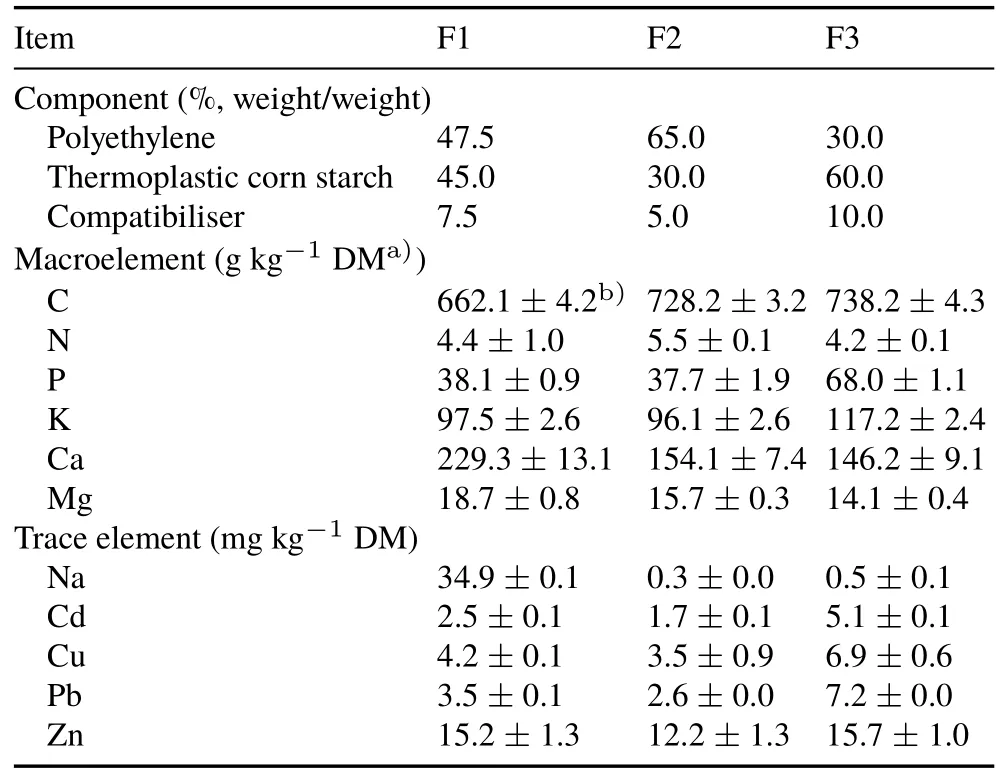
TABLE IComposition and chemical properties of polymers F1–F3 added in the composting process of the composts used in this study
The composting was conducted under laboratory conditions for 180 d in bioreactors(0.64 m3,0.8 m×1.0 m×0.8 m)that were equipped with aeration and leachate discharge systems.Aeration of the composted biomass was performed by injecting air into the bioreactors at 0.1 m3min-1for 4 times a day.Once a week,the composted biomass was mixed to provide better aeration and homogenisation.Up to the 90th day of the process,the humidity of the biomass was maintained at 50%–60%and then to at 45–50%at the 180th day(Mierzwa-Herszteket al.,2018).The basic chemical properties of the composts with addition of polymers are presented in Table II.
Experimental design
A 2-year field experiment(Małopolska Province,Krakow)in 2016–2017 was performed in two locations using two different soil types,a Cambic Phaeozem and a Luvic Phaeozem(IUSS Working Group WRB,2015).The physical and chemical properties of these soils are presented in Table III.

TABLE IIChemical properties of the composts without(C)or with polymers F1–F3a)added during composting(C+F)
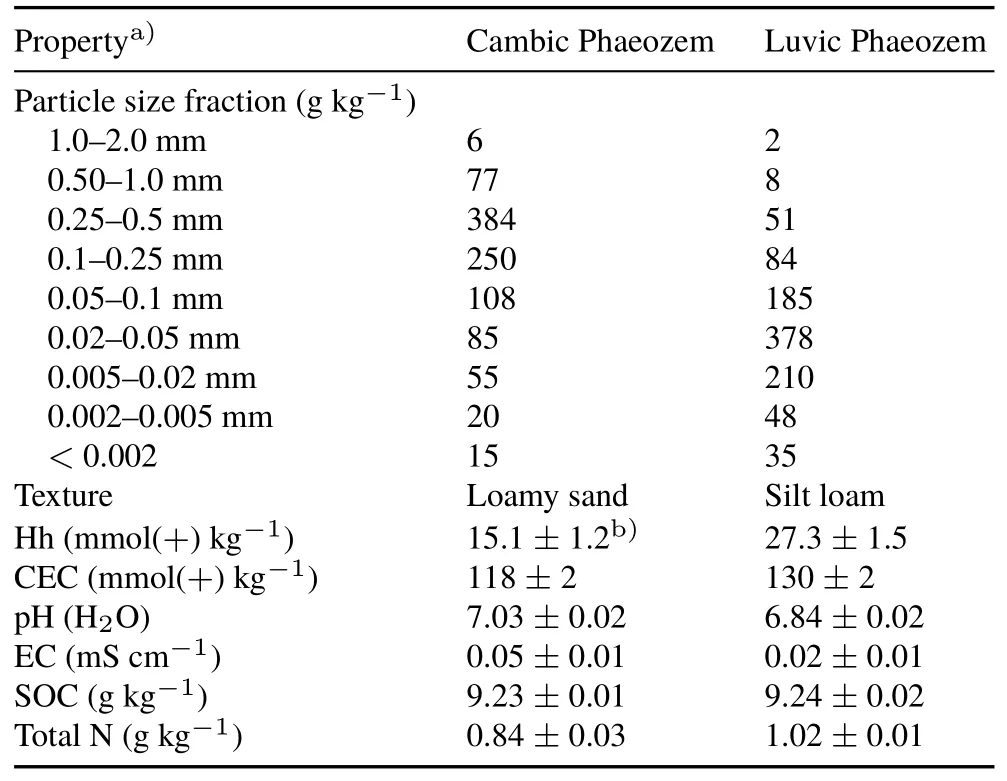
TABLE IIIPhysical and chemical properties of the two investigated soils
The experiment used a randomised block design,with three replications.The plot area was 1 m2.The experimental design for both types of soil included 7 fertilisation treatments:control without fertilisation(CK);mineral fertilisers(MF);compost with no polymer added and with supplementary mineral fertilisation(MF+C);compost with the polymer F1 added and with supplementary mineral fertilisation(MF+C+F1);compost with the polymer F2 added and with supplementary mineral fertilisation(MF+C+F2);compost with the polymer F3 added and with supplementary mineral fertilisation(MF+C+F3);and compost with the polymer F3 and a microbiological inoculum added and with supplementary mineral fertilisation(MF+C+F3+M)(Mierzwa-Herszteket al.,2014).The compost application rates per hectare(in the first year)were 5.41,4.65,4.65,4.81,and 4.31 t dry matter(DM)for the MF+C,MF+C+F1,MF+C+F2,MF+C+F3,and MF+C+F3+M treatments,respectively.These compost rates provided 170 kg N ha-1.The same N dose(170 kg N ha-1)in the form of ammonium nitrate was used in the MF treatment.In addition,each treatment,except CK,was amended with supplementary mineral fertilisation with phosphorous(P)and potassium(K),at rates up to 40 kg P ha-1and 120 kg K ha-1,respectively.Phosphorous was applied once for the first crop in the form of enriched triple superphosphate,K was in the form of a potassium salt,and N was in the form of ammonium nitrate.Assuming that three crops were to be harvested,P and N were divided into three equal parts(for each harvest).In the second year of the experiment,mineral fertilisers(100 kg N ha-1,40 kg P ha-1,and 120 kg K ha-1)were applied in each treatment,except CK.After the application of composts and mineral fertilisers,perennial ryegrass(Lolium perenneL.)seeds were sown.
Sampling and analysis of composts and soil properties
Before and at the end of the 2-year experiment,soil samples(about 0.5 kg)were collected from the 0–20 cm layer of each plot.Three replicate soil samples were randomly excavated in each plot using a soil drill(diameter,4 cm)and then mixed to produce a composite sample.The samples were air dried,passed through a 2-mm mesh sieve,and stored in the dark at 12–16°C until analysis.
Prior to analysis,the compost and soil samples were dried at 70°C and ground to pass through a 2-mm sieve.pH was measured using a CP-505 pH meter(Elmentron,Zabrze,Poland),and electrical conductivity(EC)was measured using a CCO-501 conductometer(Elmentron).The DM content was measured after drying the samples at 105°C for 12 h,and the ash content was measured after ashing the samples in a chamber furnace at 550°C for 8 h.Total N content was determined using the Kjeldahl method with a Kjeltec 1026 System II Distillation Unit apparatus(Foss,Hilleroed,Denmark).Soil organic C(SOC)content was analysed using the Tiurin method.The sum of the exchangeable alkaline cations(EAC)and hydrolytic acidity(Hh)were determined using the Kappen method(Jaremko and Kalembasa,2014).Cation exchange capacity(CEC)was calculated as the sum of Hh and EAC.
To determine selected physical parameters of the soils 2 years after application of composts,air-water relationships were identified,and soil micromorphological analyses were performed on the soil samples collected at the end of the 2-year experiment.Undisturbed soil samples were taken using cylinders(100 cm3volume)in triplicate from each plot.Soil bulk density(BD)was determined in the 100-cm3cylinders,soil particle density(Dp)was determined using the pycnometric method(Blake and Hartge,1986),soil total porosity(TP)was calculated based on the Dp and BD values,and soil water retention curves were determined in undisturbed soil samples using the Richard method,with porous plates(Soil Moisture Equipment Corp.,Santa Barbara,USA).Seven matric potentials were used,namely,-4,-10,-33,-100,-200,-500,and-1 500 kPa(Klute and Dirksen,1986).Soil water retention curves were fitted to the parametric model of van Genuchten(1980)using the RETC program(PC-Progress,Prague,Czech Republic)(van Genuchtenet al.,1991)according to the following equation:

whereθis the soil water content(cm3cm-3),his the matric potential(kPa),θsis the saturated water content(assuming equivalence with TP),θris the residual soil water content,which is associated with the immobile water present within a dry soil sample(ath=∞),andαandnare the model parameters.The following soil quality parameters were calculated:field capacity(FC),defined as the equilibrium volumetric soil water content ath=-10 kPa(Marshallet al.,1996);permanent wilting point(PWP),which is the volumetric soil water content ath=-1 500 kPa(Marshallet al.,1996);plant-available water content(PAWC),calculated as the difference between FC and PWP;the sum of macropores(MP),calculated as the difference between TP and PWP;and relative field capacity(RFC),defined by Reynoldset al.(2008)as the proportion between FC and TP.
Soil micromorphological analysis
Microscopy and image analysis techniques are recognised as very useful tools for direct,comprehensive quantitative and qualitative analyses of soil artefacts,including micromorphological assessment of soil(Stoops,2003).Microscopic analysis allows the overall assessment of the physical and chemical indicators of soil quality,by determining the mineral composition,porosity,and amount and quality of OM(Gerasimova and Lebedeva-Verba,2010).It also indicates the size and shape of the mesofauna faeces,thus providing direct proof of the biological activity of soil(Stoops,2003).To identify the microstructures of the tested soils,soil samples with an intact structure were collected as a spatial system of mineral and organic components in relation to free space and were treated in an Epovac vacuum chamber(Struers,Ballerup,Denmark)using an Araldite 2020 A/B epoxy resin(Mazureket al.,2016).The obtained soil material was used to prepare 100 μm×76 mm×52 mm soil slides using a CL50 apparatus(Logitech Ltd.,Glasgow,UK).According to VandenBygaart and Protz(1999),a 76 mm×52 mm slide is a representative sample that is useful for describing the most important micromorphological properties of soil.Samples were observed under an Eclipse 400 polarisation microscope(Nikon,Tokyo,Japan).The micromorphological analysis of soil samples involved i)soil microstructure types I°and II°,ii)the size and shape of the pores,iii)the presence and proportion of the mineral and organic components,iv)the presence of artefacts,v)the biological activity(by measuring the amount and quality of the fauna waste within soil),vi)the degree of organic matter decomposition,vii)the microskeleton index as a ratio of coarse(c)and fine particles(f)adopting a 5-μm limit value(c/f5),and viii)types of soil micromass(Stoops,2003;Mazureket al.,2016).The soil structure and other micromorphological features were described using the nomenclature introduced by Stoops(2003),which is a standard method for describing such results.The soil structure was described on the basis of a binary image of thin soil slides that were previously completely scanned.The software Aphelion ver.3.2(ADCIS,Saint-Contest,France)was used for image analysis and porosity determination.The solid phase was marked in black,and the free space was marked in white.
Statistical analysis
Analysis of variance for a randomised block design was performed to evaluate the effects of compost mixture and soil type on soil physical parameters,using the statistical software package Statistica ver.13.0(StatSoft Inc.,Tulsa,USA).Means were compared using a Bonferroni test,with a level of significance ofP<0.05.Spearman’s rank correlation and regression analyses were performed to analyse the relationships between soil parameters.
RESULTS AND DISCUSSION
Soil Dp and BD
The Dp values were similar in the Cambic Phaeozem and the Luvic Phaeozem,reaching an average of 2.56 g cm-3(Table IV).The compost treatments significantly affected the Dp values.The lowest Dp value for the Luvic Phaeozem was found in the MF treatment.However,for the Cambic Phaeozem,the lowest Dp value was seen in the MF+C+F3 treatment.In the Luvic Phaeozem,Dp values were more variable with different treatments,ranging from 2.44 to 2.59 g cm-3.
The two investigated soil types showed significantly different BD values,being 1.48 g cm-3for the CambicPhaeozem and 1.39 g cm-3for the Luvic Phaeozem(Table IV).Fertilisation with composts amended with artificial polymers did not significantly change the BD values in either soil type.Bazzoffiet al.(2006)also reported an increase in the BD value in soil fertilised with different doses of compost.However,Maghchicheet al.(2010)and Chenet al.(2016)showed that polymers can significantly improve the physical properties of soil,especially sandy soil prone to erosion and periodical water shortage,by improving soil air and water parameters.According to Celiket al.(2010)and Mierzwa-Herszteket al.(2014),the application of OM to soil has a diluting effect and reduces soil density.Additionally,Tejadaet al.(2009)reported reduced BD values after fertilisation with composts under experimental conditions on a microplot and explained this as a result of the loosening of soil compact mineral fraction because of increases in soil porosity and structural stability.Kellnet al.(2012)reported that the application of compost decreased soil density and clearly showed a beneficial effect on soil structure.It should be noted that the compost doses used in the present study were responsible for the small differences in the BD values between CK and the fertilised treatments.The lack of significant differences in BD values between individual treatments may have also resulted from the establishment of a certain state of equilibrium,taking into account the soil and meteorological conditions.
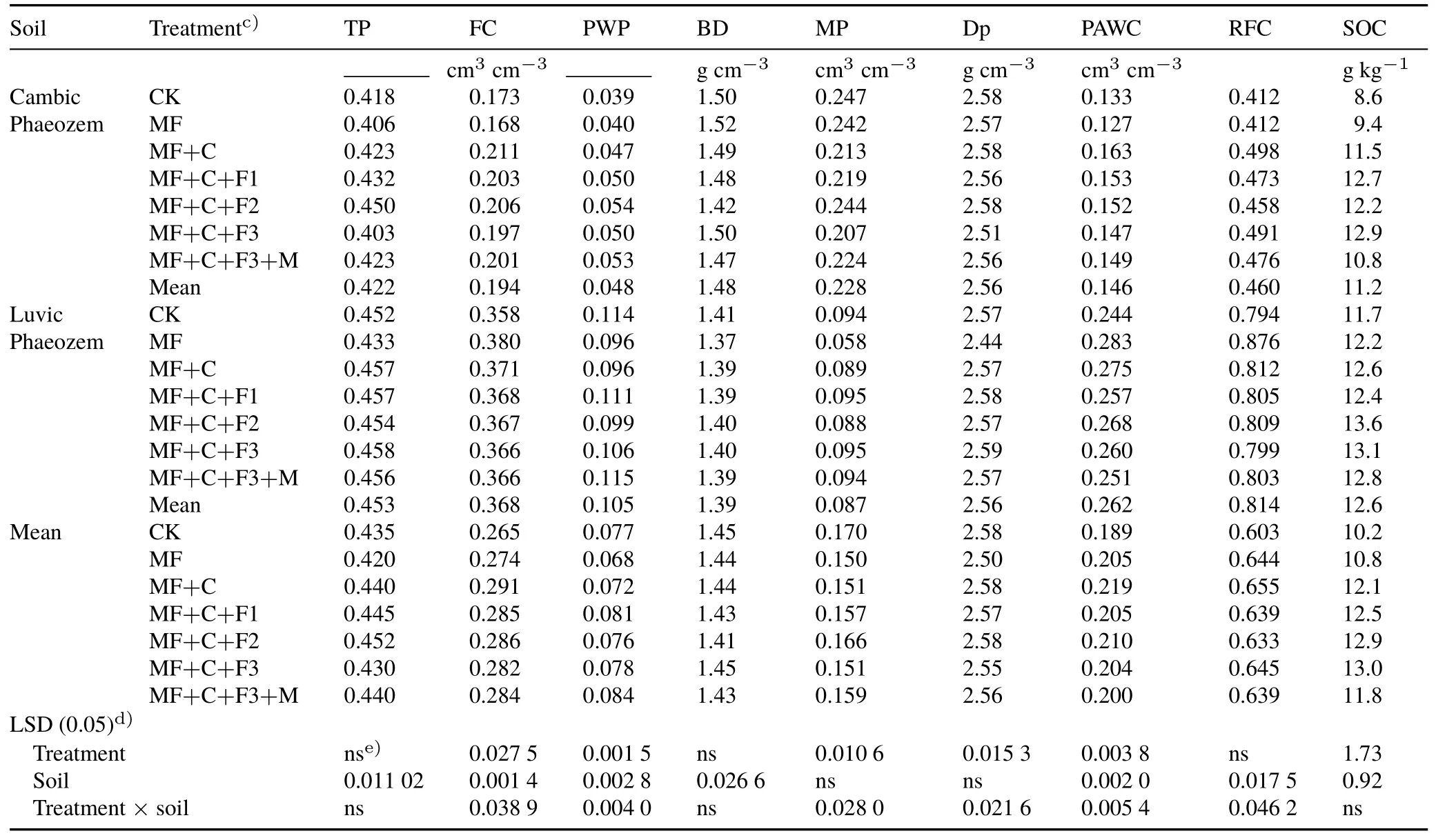
TABLE IVEffects of composts with polymers F1–F3a)added during composting on soil physical parametersb)and soil organic C(SOC)after the 2-year pot experiment
As stated by Paluszek(2011),soils with sand and clay texture at the humus level(Ap horizon)generally have BD values ranging from 1.50 to 1.70 g cm-3.Arshadet al.(1996)determined that the optimal soil density for root growth should not exceed 1.60 g cm-3.None of our treated soils exceeded that value.With the use of empirical formulae,Pabinet al.(1999)showed that the BD range should be 1.38–1.53 g cm-3in loamy soils and 1.48–1.65 g cm-3in sandy soils.Our results using the Cambic Phaeozem and Luvic Phaeozem were within these proposed ranges.The application of composts with polymers did not increase the soil density and consequently did not adversely affect soil air-water relationships.According to Weber and Jamroz(2004),the decrease in soil compaction after fertilisation with composts is greater than the decrease in soil density and is observed only in the year of compost application.Arthuret al.(2012)and Aranyoset al.(2016)observed compaction of sandy soils after compost application and found that this compaction was due to a significant increase in SOC content,which was confirmed by the presence of a strong negative correlation between these two parameters.
We also found a strong negative correlation between soil BD and SOC(P<0.05),withrvalues of-0.36 for the Cambic Phaeozem and-0.43 for the Luvic Phaeozem(Table V).According to Celiket al.(2004),changes in BD after the application of composts depend exclusively on their mineralisation rate.A slower rate of mineralisation is associated with a longer positive effect of the compost fertilisation on soil BD.Grosbelletet al.(2011)reported that exogenous OM had a positive effect on the physical properties of soils used for agriculture,physically protecting aggregates from degradation.They suggested that when organic particles broke down,they surrounded the aggregates already present in soil with a fine film and protected them from degradation.
Soil TP and MP
Changes in soil BD after using composts also affected soil TP.According to Naveedet al.(2014),soil TP linearly follows the gradient of SOC.In our study,soil TP depended only on the soil type and not on the type of compost used(Table IV).The TP values of 0.422 cm3cm-3for the Cambic Phaeozem and 0.453 cm3cm-3for the Luvic Phaeozem were within the optimal range for mineral soils(0.20–0.75 cm3cm-3)(Paluszek,2011).The lack of differences in soil TP values between compost treatments may have been due to the relatively low compost rates.The results obtained by Babalolaet al.(2012)and Aranyoset al.(2016)confirmed increases in TP in soils fertilised with compost.As reported by Aranyoset al.(2016),the increase in soil porosity is closely related to the increase in soil OM content.Fertilisation of soil with organic material at doses from 9 to 27 t ha-1can increase soil TP by up to 20%.In the present study,soil TP was positively correlated with SOC(Fig.1).Aranyoset al.(2016)also reported a negative correlation between soil BD and air permeability.They showed that an increase in soil density by 0.1 g cm-3resulted in a significant decrease in the soil air permeability.Grosbelletet al.(2011)argued that pore creation resulted from OM fractionation and the consumption of OM particles by microorganisms.The relationships between the amounts of compost used and changes in TP,BD,and PAWC have been confirmed in a previous report by Weber and Jamroz(2004).They statedthat increases in TP and PAWC were generally only observed at high doses of compost and the effect of compost on soil porosity depended mainly on soil texture and the type of compost used.

TABLE VCorrelation coefficient matrix of soil parameters after the 2-year pot experiment with application of composts

Fig.1 Relationships of soil organic C content(SOC)with soil field capacity(FC)and total porosity(TP)after the 2-year pot experiment with application of composts.
Soil MP is an indicator of the volume of non-capillary pores that are used to gravitationally drain excess water from soil and to exchange gas between plant,soil,and atmosphere(Arshadet al.,1996;Mohammadshiraziet al.,2016).Optimum MP values are usually assumed to be in the range of 0.12–0.15 cm3cm-3.In this study(Table IV),the MP values were from 0.21 to 0.25 cm3cm-3for the Cambic Phaeozem,higher than the optimum range,and ranged from 0.058 to 0.095 cm3cm-3for the Luvic Phaeozem,lower than the than the optimum range.The MP values below 0.10 cm3cm-3have previously been reported for arable soils(Mazurek,2015).The results of the present study showed that soil fertilisation with composts amended with polymers generally decreased the MP values for the Cambic Phaeozem,but significantly increased the MP values for the Luvic Phaeozem,compared to the MF treatment.
Soil TP was also used as one of the parameters to determine the boundary conditions for adjusting the soil water retention curves(van Genuchtenet al.,1991).Water retention curves are necessary to determine the water-soil constants and are a function of the dependence between the parental potential and soil moisture(van Genuchtenet al.,1991;Hewelkeet al.,2013).In our study,the retention curves were different between the two types of soils tested(Fig.2),which was due to variability in soil property.However,the treatments within the same soil type showed similar curve shapes for potentials up to-155 kPa.

Fig.2 Soil water retention curves,based on the van Genuchten equation,for the two soils investigated,a Cambic Phaeozem(a)and a Luvic Phaeozem(b),with or without application of mineral fertilisers and/or composts with or without polymers(F1–F3)added during composting,after the 2-year pot experiment.See Table I for details of the polymers F1–F3.CK=control without fertilisation;MF=mineral fertilisers;MF+C=compost with no polymer added and with supplementary mineral fertilisation;MF+C+F1=compost with the polymer F1 added and with supplementary mineral fertilisation;MF+C+F2=compost with the polymer F2 added and with supplementary mineral fertilisation;MF+C+F3=compost with the polymer F3 added and with supplementary mineral fertilisation;MF+C+F3+M=compost with the polymer F3 and a microbiological inoculum added and with supplementary mineral fertilisation.θ=water content;h=water potential.
Soil FC and PWP
Soil FC and PWP are considered the most important properties of soil water(Arshadet al.,1996;Paluszek,2011;Hewelkeet al.,2013;Mohammadshiraziet al.,2016).In our study,different treatments showed distinct differences in soil water characteristics(Table IV).The FC values ranged from 0.17 to 0.21 cm3cm-3for the Cambic Phaeozem.However,for the Luvic Phaeozem,the FC values were less varied,ranging from 0.36 to 0.38 cm3cm-3.For the Cambic Phaeozem,the compost treatments significantly increased PWP compared to CK and the MF treatment.Compared to CK,a decrease in PWP was observed in the compost and MF treatments for the Luvic Phaeozem.According to Brown and Cotton(2011)and Adugna(2016),soil water retention capacity depends on the amount of water that is able to infiltrate deep into the soil profile and the amount of water that the soil can hold.It is mainly influenced by soil textural parameters and OM content.Therefore,loamy soils tend to have a much greater water retention capacity than sandy soils.Brown and Cotton(2011)showed a positive correlation between SOC content and soil FC and a negative correlation between soil density and FC.This was also confirmed by our results(Fig.1).In addition,Brown and Cotton(2011)reported that the effect of compost application to a soil on the physical properties of the soil,including FC,may differ,which is related not only to soil type of,but also to the dose and type of feedstock from which the compost was produced.For example,Adugna(2016)found a significant improvement in water infiltration in sandy soils after using only compost from bovine manure,at a dose of 120 t DM ha-1.In our study,we used compost doses(4.31–5.41 t DM ha-1)more than 20-fold lower than that dose.
Soil RFC
To determine the ability of a soil to retain water and air in relation to the total pore volume,the index RFC is recommended(Reynoldset al.,2008).This coefficient ranged from 0.41 to 0.49 for the Cambic Phaeozem and from 0.79 to 0.81 for the Luvic Phaeozem.For both soil types,RFC increased with application of composts with polymers when compared with CK.As reported by Reynoldset al.(2008),a balance between water capacity and air capacity occurs in arable soils when the FC-to-TP ratio is in the range of 0.6–0.7,and the intensity of the nitrification process is reduced when the ratio is below 0.6,due to a lack of soil water.However,many studies have found that the determination of optimal air capacity is difficult because FC and air capacity are contradictory properties(Reynoldset al.,2008;Paluszek,2011;Hewelkeet al.,2013).It is assumed that the balance between water and air in soil is maintained when soil PWP constitutes approximately 60%of soil TP.
Soil PAWC
As showed in Table IV,the PAWC depended significantly on the type of soil and the type of compost applied.This was particularly evident for the Cambic Phaeozem,where the use of compost significantly increased the PAWC(by 15%on average)compared with CK and the MF treatment.For the Luvic Phaeozem,the use of compost with polymers had the opposite effect;i.e.,it significantly decreased the PAWC(by 6%on average)compared with the MF treatment.Our results are consistent with those of Weber and Jamroz(2004),who demonstrated that the use of natural and organic fertilisers increases soil water retention,with OM content having an important impact on this parameter.For this reason,the beneficial effect of small doses of composts on water retention is usually of short duration,and the effect is greater in sandy soils and immediately after the introduction of compost.Maghchicheet al.(2010)tested various mixtures of composts and polymers and showed that these mixtures can act as a barrier in a Cambic Phaeozem,protecting against water loss and increasing the efficiency of water use by plants.Additionally,Chenet al.(2016)showed that the addition of polymers to a sandy soil significantly improved its structure and its retention of water and nutrients for plants.They estimated that the introduction of 0.03%–3%artificial polymers can increase water retention in the sandy soil by 24%–66%.
The PAWC values obtained in the present study were in the range specified in previous studies.According to the range proposed by Walczaket al.(2002),the Cambic Phaeozem had a medium retention of PAWC,and the Luvic Phaeozem had a high retention of PAWC.Craulet al.(1999)demonstrated that fine-textured soils had the best retention capacity because they were rich in humus and possessed a durable aggregate structure.They also assumed a limit of PAWC of 0.200 cm3cm-3,above which conditions were ideal for the maximum growth and functioning of plants.
Soil PWP
Our results did not clearly confirm the influence of the type of compost with polymers on PWP(Table IV).For the Cambic Phaeozem,a significant increase in PWP was found with the compost treatments,compared with the MF treatment and CK.The highest value was seen for the MF+C+F3 treatment.For the Luvic Phaeozem,a significant increase in PWP was seen for all treatments,compared with the MF treatment.The application of compost to the soil did not cause any changes in PWP compared to CK.It should be emphasised that the addition of polymers to the composted biomass did not decrease the PWP value.According to Walczaket al.(2002),the PWP values for fine-and mediumtextured soils should range from 0.050 to 0.150 cm3cm-3.The values obtained in our study were within this range,except for those for the Cambic Phaeozem in CK and the MF and MF+C treatments.
Soil micromorphological properties
To assess the impact of management practi ces on soil environment,it is necessary to quantify modifciations of soil structure.Soil micromorphological investigations are a useful tool for the general interpretation of soil quality by assessing soil physical,chemical,and biological properties(Stoops,2003;Gerasimova and Lebedeva-Verba,2010;Mazurek,2015;Wierzbicka-Mierniket al.,2015).Because this assessment is performed in intact soil,it is possible to distinguish many pedogenic traits of the sample,including the illuvial displacement of the colloidal fraction,the type of microstructure,the presence of iron(Fe)or carbonate concretions,the degree of mineralisation,the proportion of biogenic pores,and the degree of OM decomposition(Gerasimova and Lebedeva-Verba,2010;Wierzbicka-Mierniket al.,2015).Additionally,based on the size and shape of mesofauna faeces in a soil,quantitative and qualitative assessments of its composition are possible(Stoops,2003;Mazurek,2015).The so-called groundmass,which constitutes a general description of the coarse and fine material(and the free spaces between them),can also be assessed.For the parameters described,a 5-μm boundary was adopted,as the commonly used range is 3–20 μm(Stoops,2003;Mazurek,2015).A coarse fraction(>2 mm)was individually separated from the tested material to identify the skeletal material(sandstone and silica rock).Considering that the microscopic analysis of the individual elements of fine material is very difficult,their features,occurrence,spatial organisation,and b-fabric are described on the basis of selected optical properties,such as interference colour,colour,and transparency.
Detailed microscopic analysis showed that the type of compost used did not significantly affect the proportions of individual soil fractions in the Cambic Phaeozem.They were visible primarily in the form of mineral composition,consisting mainly of differently rounded(subangular)grains of quartz and feldspar(Table VI,Fig.3),ranging in size from 20 to 500 μm,with an average size of approximately 200 μm.To a lesser extent,mica and clay minerals were also observed.Locally,larger fragments of silica rock were visible in the images of thin sections(Fig.3).
All slides obtained from the Cambic Phaeozem samples showed a granular I°microstructure,resulting in the formation of pores with complex packing voids(Fig.3).In some cases,larger pores in the form of chambers were observed.Aggregates in the images of thin slides showed a poor separation of soil material,resulting mainly from sandy graining.The lower-level structure had a spongy nature,which was due to the presence of mostly well-decomposed OM.In general,the surface porosity of the soil samples with the grain-size structure of clay was relatively small and ranged from 5%to 17%(Table VI).According to the system proposed by Pagliaiet al.(2004),the Cambic Phaeozem can be classified as compact(in CK and the MF+C,MF+C+F2,MF+C+F3 treatments)or moderately porous(in the MF,MF+C+F1,MF+C+F3+M treatments).
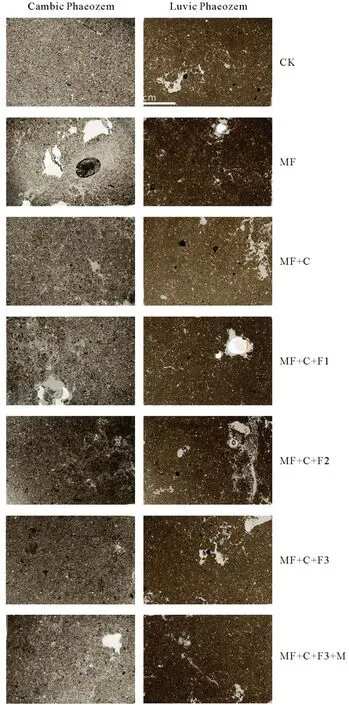
Fig.3 Soil microstructures of the 0–10 cm layer for the two soils investigated,a Cambic Phaeozem(a)and a Luvic Phaeozem(b),as affected by composts with polymers(F1–F3)added during composting after the 2-year pot experiment.See Table I for details of the polymers F1–F3.CK=control without fertilisation;MF=mineral fertilisers;MF+C=compost with no polymer added and with supplementary mineral fertilisation;MF+C+F1=compost with the polymer F1 added and with supplementary mineral fertilisation;MF+C+F2=compost with the polymer F2 added and with supplementary mineral fertilisation;MF+C+F3=compost with the polymer F3 added and with supplementary mineral fertilisation;MF+C+F3+M=compost with the polymer F3 and a microbiological inoculum added and with supplementary mineral fertilisation.
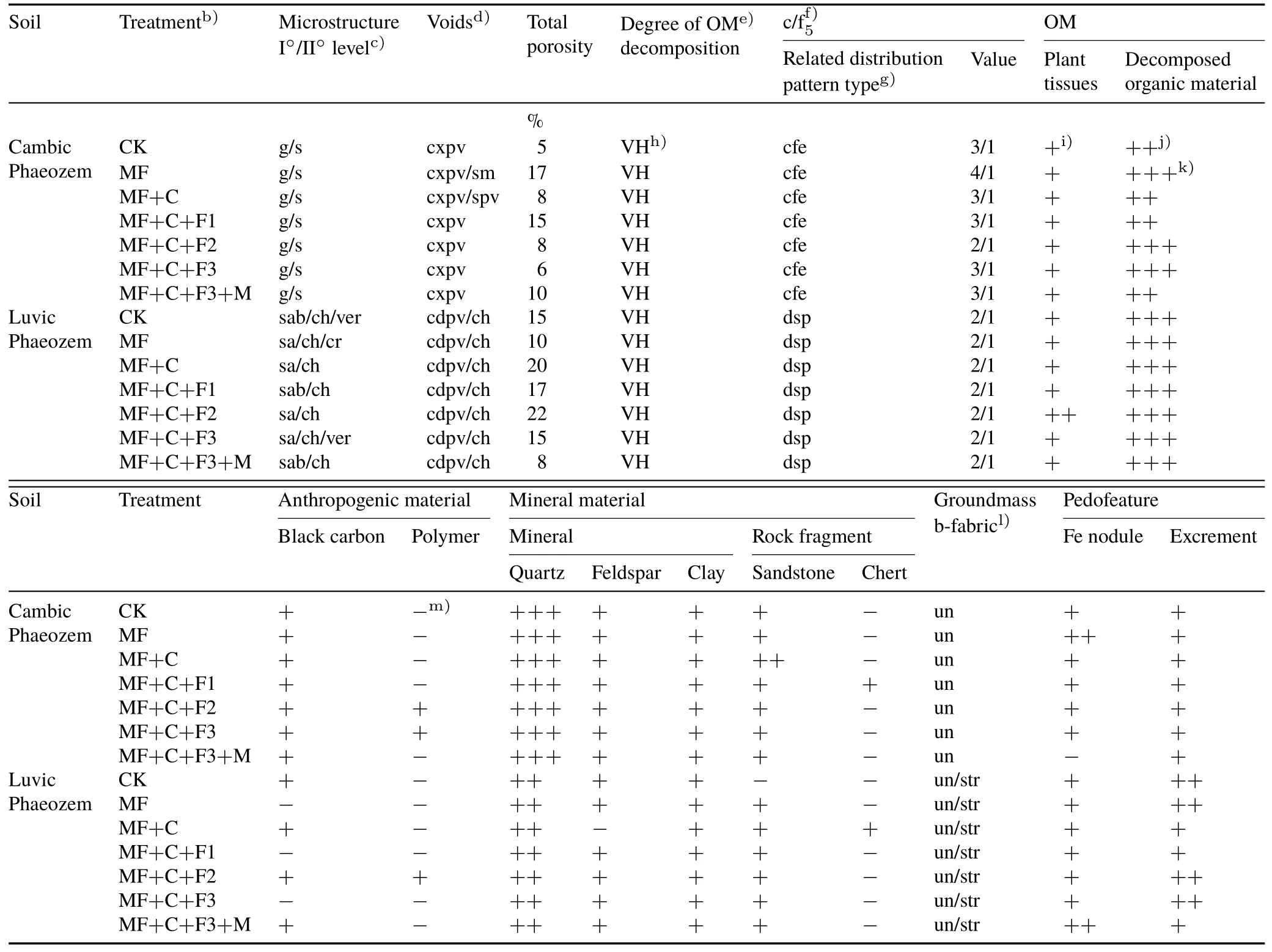
TABLE VIMicromorphological properties of light and medium fractions of the two soils investigated,a Cambic Phaeozem and a Luvic Phaeozem,as affected by composts(C)with polymers F1–F3a)added during composting after the 2-year pot experiment
Micromorphological features,indicating the progression of the soil-forming process,are primarily related to the accumulation and decomposition of OM(Pagliaiet al.,2004;Gerasimova and Lebedeva-Verba,2010;Mazurek,2015;Wierzbicka-Mierniket al.,2015).The OM visible in the images of all the tested slides(obtained from the soils with the grain size structure of light clay)showed a high degree of decomposition and anisotropic characteristics(Fig.3).However,the highest degree of OM decomposition among the Cambic Phaeozem samples was seen in the MF,MF+C+F2,and MF+C+F3 treatments(Table IV).In all samples,poorly decomposed plant residues,with visible tissue structures,were present locally.In the microscopic images of the Cambic Phaeozem slides,many fauna faeces were observed,indicating a high level of biological activity.
The slides of the Cambic Phaeozem were dominated by a close,fine enaulic microskeleton(Table IV).The coarseness of sandy soil material created an advantage over fine soil material and translated into a high c/f5value.The highest value of c/f5(4/1)was seen for the MF treatment.This value indicated that in the basic mass of the soils collected for this treatment,there was 4 times more coarse material than fine material.For the treatments with compost with artificial polymers,the c/f5values were generally 3/1.The tested fine soil mass had a dark,almost black colour and showed neither distinct variation nor the formation of bands.These were mainly humus substances.
Among the treatments in the Cambic Phaeozem,anthropogenic material,in the form of fragments of nondecomposed polymers,was found only in the MF+C+F2 and MF+C+F3 treatments(Fig.3).Additionally,carbides were seen in all treatments in the Cambic Phaeozem.The presence of numerous Fe3+nodules(of anorthic type)was a characteristic feature for the Cambic Phaeozem,which indicated periodic difficulties associated with the infiltration of rainwater.This phenomenon was especially visible in the MF treatment,but was not observed in the MF+C+F3+M treatment(Table IV).
The slides of the Luvic Phaeozem samples showed a structure typical of soils with a silt particle size(Fig.3).The microstructure of these soil samples was classified as subangular and subangular blocks(Table IV).The lower microstructure level indicated the presence of a tubular-type microstructure,which indicated high levels of mesofauna(e.g.,earthworms)activity in the Luvic Phaeozem.Earthworm activity was most noticeable in CK(Fig.3).Variability in the vermicular structure and the formation of a characteristic aggregate-based microstructure were also observed.The mineral composition of the Luvic Phaeozem(irrespective of the fertilisation applied)was dominated by quartz fragments,mainly in angular forms.More rarely,in the case of larger crumbs,subangular grains were found(Table VI).The size of the quartz fragments in the majority of samples ranged from 20 to 100 μm.Additionally,in all samples except that of the MF treatment,feldspars and micas were found.Clay minerals that form complexes with humus substances were also present in the micromass in each image of the treated Luvic Phaeozem soil samples.These structure types were characterised by poor to moderate separation of soil material.Complex pores were the free spaces between the coarse and fine material in the groundmass.Some pores were partially or completely filled with manure from soil animals(Fig.3).
The surface porosity of both types of soils was highly variable and ranged from 8% to 22%,regardless of the fertilisation applied.A porosity level≤10%(characteristic of soils with a compact structure)was found in all treatments in the Cambic Phaeozem except MF+C+F1 and in the MF and MF+C+F3+M treatments in the Luvic Phaeozem.Other treatments showed moderate porosity.According to Pagliaiet al.(2004),a soil porosity of 10% is the lower limit for good-quality soils.Some pores in the tested soils contained poorly decomposed plant residues,and in pores of a biogenic nature,large spaces were visible in the form of highly branched pores and chambers(Fig.3).However,neither clay liners nor crystalline structures were found in these pores.
The Luvic Phaeozem had an average c/f5value of 3:1(Table IV),with a double-spaced porphyric system.However,larger grains(mainly of quartz)were relatively far from each other(Fig.3).The visible micromass on the structure of selected brown surface areas was generally a combination of humic substance with mineral components(clay minerals)in a strong dispersion state(Fig.3).With regard to pedofeatures,the Luvic Phaeozem showed many anorthic nodules that were composed of Fe3+compounds,with a characteristic brown colour.The highest number of Fe nodules in the images of the thin slides was found in the MF+C+F3+M treatment for the Luvic Phaeozem.This was confirmed by the decreased porosity in this treatment(Fig.3).According to Pagliaiet al.(2004),the use of external OM,in the form of compost and manure,improves soil porosity and aggregation.Improved aggregation indicates that the addition of organic material plays an important role in preventing the formation of soil crust.These results confirm that it is possible to adopt alternative tillage systems to prevent physical soil degradation and that the use of organic material is necessary to improve soil structure.
CONCLUSIONS AND PERSPECTIVES
The investigated composts with polymers(with different amounts of thermoplastic corn starch and polyethylene)added during composting improved soil water retention and increased soil retention,indicating that these composite mixtures could be successfully used in agriculture,especially to improve the structure of sandy soils.The use of compost led to changes in the soil retention capacity and improved soil accessibility for growing plants,and the dose of the compost was an important factor in determining its effectiveness.It should be emphasised that the composts applied in this study affected the Cambic Phaeozem to a greater extent than the Luvic Phaeozem.This was due to the filling of large spaces in the soil with finer material,resulting in increased water retention.This correlation was also confirmed by the results of micromorphological investigations and the soil water retention curves.Our study suggests that composts amended with composite synthetic and natural material-derived polymers can be widely used in the soil reclamation of degraded areas(e.g.,through soil sealing as structure-forming material)and in the soilless cultivation of horticultural plants(e.g.,highincome crops grown in pots or mats under roofs).Composts amended with polymers may also be used in the ornamental plant market(perennials,shrubs,trees,and flowers)as this industry requires very large volumes of substrates,including those based on biodegradable polymer composts.The cost of producing compost from post-consumer polymers may be higher than the cost of composting natural material.However,the added value here is the attempt to close C cycle and achieve its longest possible time of binding in soil,to reduce CO2emissions.Thus,the profits and losses can be balanced(reuse of post-consumer material),and a clear economic assessment must take environmental aspects into consideration.
ACKNOWLEDGEMENTS
This research was financed by the Ministry of Science and Higher Education of the Republic of Poland.This research was realized within the framework of the project“Utilization of Biomass for the Preparation of Environmentally Friendly Polymer Materials”(BIOMASA)(No.POIG 01.01.02-10-123/09),partially financed by the European Union within the European Regional Development Fund.
杂志排行
Pedosphere的其它文章
- Rice productivity and profitability with slow-release urea containing organic-inorganic matrix materials
- Bacterial communities in paddy soils changed by milk vetch as green manure:A study conducted across six provinces in South China
- Efficiency of soil-applied 67Zn-enriched fertiliser across three consecutive crops
- Effect of long-term fertilization on bacterial communities in wheat endosphere
- Degradation of the fungicide metalaxyl and its non-extractable residue formation in soil clay and silt fractions
- Effect of sewage sludge and sugarcane bagasse biochar on soil properties and sugar beet production
